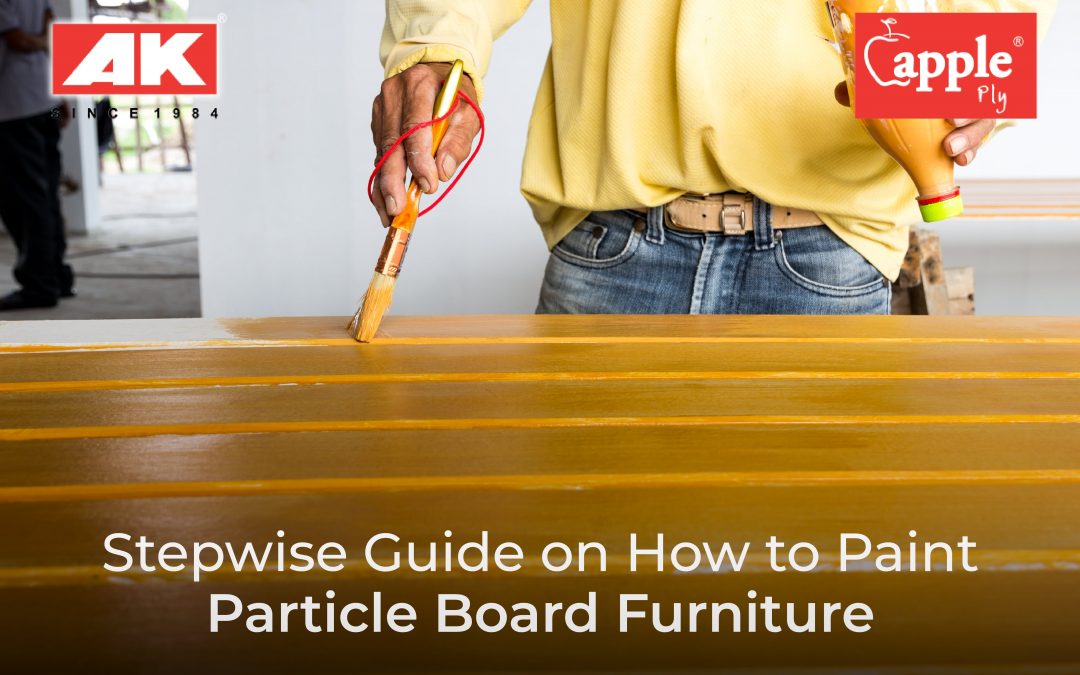Is your particle board furniture looking a bit worn out? Don’t toss it just yet! With the right techniques and materials, you can give it a stunning makeover.
In this guide, we’ll walk you through a step-by-step process on how to paint particle board furniture, covering the best paint for particle board, preparing engineered wood for painting, and more. Get ready to transform your furniture with our expert tips and tricks!
Can You Paint Particle Board Furniture?
The very first question that comes to your mind when thinking of painting a particle board is – is it possible to paint particle board furniture? Yes, you can easily paint particle board furniture for an aesthetic, and appealing look.
Is Painting Particle Board a Good Idea?
Painting particle board furniture can be a great way to give it a fresh new look. However, it’s essential to consider the pros and cons before making a decision. With the right techniques and materials, painting particle board furniture can be a cost-effective and creative way to revamp your space.
Why People Choose to Paint Particle Board?
There are several reasons why people choose to paint particle board furniture. Let’s take a look:
1. Improve Aesthetics on a Budget
Painting particle board furniture is an affordable way to update the look of your space without breaking the bank. By choosing to paint particle board furniture, you can give your old pieces a fresh new look without having to replace them.
2. Match Existing Interior Décor
Painting particle board furniture allows you to match your existing interior décor perfectly. Whether you’re going for a bold new color or a more subtle tone, painting particle board furniture gives you the flexibility to create a cohesive look in your home.
3. Extend the Furniture’s Lifespan
By painting particle board furniture, you can extend its lifespan and prevent it from looking worn out. A fresh coat of paint can cover up scratches and scuffs, making your furniture look like new again. With proper care and maintenance, your painted particle board furniture can last for years to come.
Step-by-Step Guide to Paint Particle Board Furniture
Step 1: Remove the Hardware
Items to Remove
Get started by taking out the screws, handles, corner plates, and fittings. This will give you a clean slate to work with.
Step 2: Sand the Surface
Tools Required
Grab your 120-grit sandpaper and get ready to smooth out the surface.
Technique
Lightly sand the surface to remove the laminate sheen. Be gentle to avoid over-sanding, which can damage the soft particle board surface.
Step 3: Apply Oil-Based Primer
Have you ever wondered:
Why Oil-Based Primer Works Best?
Oil-based primer prevents moisture swelling and helps paint stick better. It’s the perfect choice for painting particle board furniture.
Drying Time
Let the primer dry for at least 1 hour under sunlight. This will ensure a strong bond between the primer and paint.
Step 4: First Coat of Paint
Choosing the Right Paint
Choose oil-based paint for the best results. If you prefer latex paint, make sure to use it with an oil-based primer.
Painting Tools
Use a wide paintbrush, paint sprayer, or roller to apply the paint. Make sure to cover the entire surface evenly.
Step 5: Apply the Second Coat (Optional: Third or Fourth)
Paint Layering Tips
- Apply even layers of paint,
- Allow each coat to dry completely.
- Add more coats for a solid finish.
💡Pro Tip: Remember, patience is key when painting particle board furniture as part of your furniture makeover DIY project.
Step 6: Reassemble Your Furniture
Final Steps
Let the paint cure for 24-48 hours. Then, fix the hardware back in place. Your particle board furniture transformation is complete! You’ve successfully repainted old furniture at home. Enjoy your newly painted particle board furniture!
Common Mistakes to Avoid When Painting Particle Board
Let’s talk about some common mistakes to avoid when painting particle board furniture:
1. Skipping the Sanding Process
Don’t even think about skipping this step! Sanding is crucial when you paint particle board furniture. It helps create a smooth surface for painting and ensures better paint adhesion. Without it, your paint job might end up uneven and prone to peeling. Trust AK Plywood particle board if you don’t want that!
2. Using Water-Based Primer or Paint Directly
Water-based primers and paints can be a no-go for particle board. They can cause it to swell, leading to a rough finish and potential damage. Instead, opt for oil-based primers and paints specifically designed for particle board. Your furniture will thank you!
3. Rushing Between Coats
Slow down, friend! When you paint particle board furniture, patience is key. Rushing between coats can lead to uneven finishes, drips, and a messy outcome. Let each coat dry completely before applying the next one. Your patience will pay off with a smooth, professional-looking finish.
4. Not Sealing the Edges
Don’t forget about those edges! Unsealed edges can absorb moisture, causing the board to swell or deteriorate. Take the time to seal the edges with a primer or paint specifically designed for particle board. It’s a small step that can make a big difference in the long run.
Also, read: Particle Board vs Plywood Cabinets – Pros, Cons, Comparisons, and Costs.
Alternatives to Painting Particle Board Furniture
If you’re looking for ways to give your particle board furniture a fresh new look without painting, we’ve got you covered.
1. Use Decorative Contact Paper or Vinyl Wraps
Why not add some personality to your furniture with decorative contact paper or vinyl wraps? They’re easy to apply, removable, and come in a variety of designs and patterns.
2. Apply Laminate Sheets
Laminate sheets can give your particle board furniture a sleek, modern look. They’re durable, easy to clean, and can withstand scratches and spills.
3. Upholstery for Tables or Benches
Add some comfort and style to your tables or benches with upholstery! You can choose from a wide range of fabrics and designs to match your home decor.
4. Chalkboard or Magnetic Paint
Turn your particle board furniture into a functional piece with chalkboard or magnetic paint. Perfect for homes with kids or for adding a creative touch to your space.
Related blog: Best 7 particle Board companies in India.
Maintenance Tips for Painted Particle Board Furniture
Now that you’ve painted your particle board furniture, let’s talk about how to keep it looking its best.
1. Clean Gently and Regularly
Keep your furniture clean and dust-free with:
- Soft cloth
- Mild soap solution
- Damp (not wet) cloth
2. Protect the Finish
Protect your furniture’s finish with:
- Mats or coasters to prevent water marks and spills
- Avoid direct sunlight, which can cause fading or discoloration
3. Handle With Care
Handle your furniture with care by:
- Avoiding sharp objects that can scratch or damage the surface
- Using felt pads under legs to prevent scratching floors
4. Keep Touch-Up Paint Handy
Keep touch-up paint handy for:
- Minor repairs and scratches
- Blending with original paint to maintain a seamless finish
5. Repair Surface Damage Immediately
If you notice any surface damage, repair it immediately by:
- Sanding lightly to smooth out the area
- Re-priming and repainting to maintain a uniform finish
By following these tips, you’ll be able to keep your painted particle board furniture looking its best for years to come!
Conclusion
With the above-stated steps, you can transform your old, worn-out furniture into stunning pieces that will elevate your home decor.
If you’re looking for a high-quality paint particle board for your next project, consider AK Plywood particle board – the best particle board for painting in India.
You can buy particle boards online from AK Plywood and explore our range of engineered wood products.
Get Ready to Unleash Your Creativity!
Now that you know the secrets to painting particle board furniture, it’s time to get creative! Gather your materials, follow our guide, and transform your furniture into beautiful pieces that reflect your personal style.
Ready to Get Started?
Visit AK Apple Plywood’s website today for best paint particle board furniture to explore our range of particle board and engineered wood products. Let’s get painting!
Buy Particle Board Online Now!
Frequently Asked Questions (FAQs)
Q1: How can I paint particle wood furniture?
To paint particle wood furniture, start by sanding the surface to smooth out any rough edges. Then, apply an oil-based primer to prevent moisture absorption. Finally, use a high-quality paint specifically designed for particle board, and apply thin coats, allowing each coat to dry completely before applying the next one.
Q2: What type of paint should be used on particle board cabinets?
For particle board cabinets, it’s best to use oil-based paint or latex paint with an oil-based primer. Oil-based paint adheres well to particle board and provides a durable finish. Make sure to choose a paint that’s specifically designed for use on particle board.
Q3: Can I paint particle board without using a primer?
It’s not recommended to paint particle board without using a primer. Particle board is prone to moisture absorption, which can cause the paint to peel or flake off. Using a primer helps to create a smooth surface and ensures better paint adhesion.
Q4: How can I make paint stay on particle board?
To make paint stay on particle board, use a high-quality primer and paint specifically designed for particle board. Sand the surface before painting, and apply thin coats of paint, allowing each coat to dry completely before applying the next one, ensuring a smooth and long-lasting finish.
Q5: What is the difference between particle board and MDF?
Particle Board
- Made from wood chips and resin
- Lightweight, lower density
MDF (Medium Density Fiberboard)
- Made from wood fibers
- Denser, smoother surface, better for painting
Dr. Prasanth M.A. is the Director of AK Applye Plywood, a trusted name in the plywood and interior solutions industry. With over a decade of expertise in wood technology and sustainable manufacturing, he is passionate about delivering high-quality, innovative plywood products that meet both functional and aesthetic needs. Dr. Prasanth is committed to promoting eco-friendly materials and has been a key figure in driving industry best practices in durability, design, and customer-centric solutions. Under his leadership, AK Applye Plywood has grown into a brand synonymous with quality craftsmanship and reliability in the Indian plywood market.




